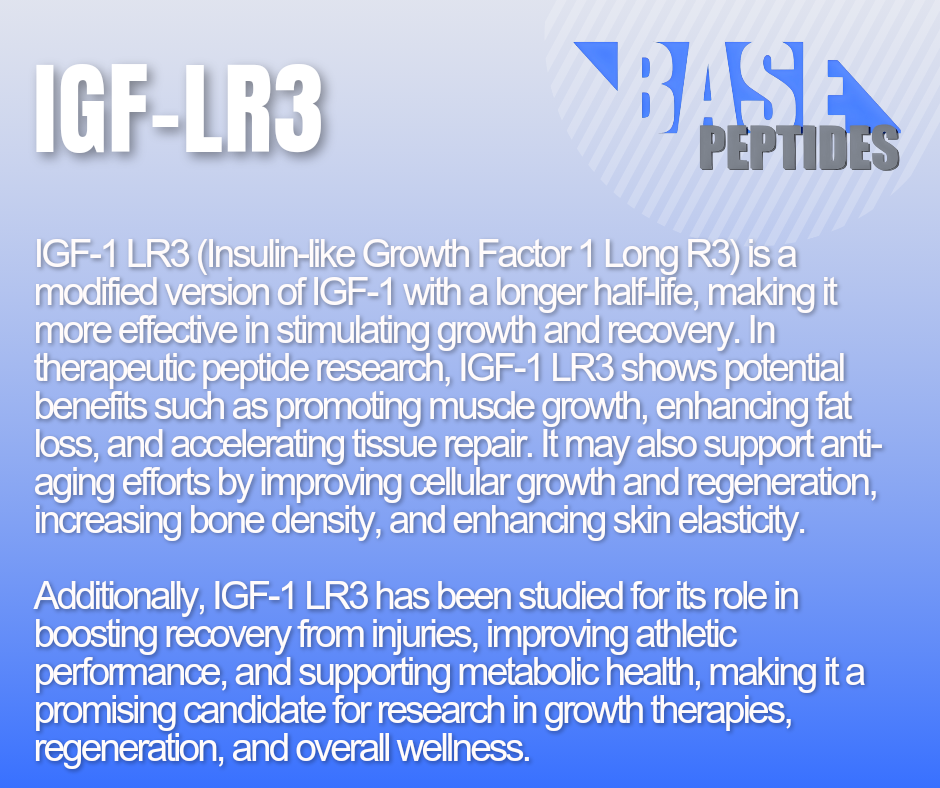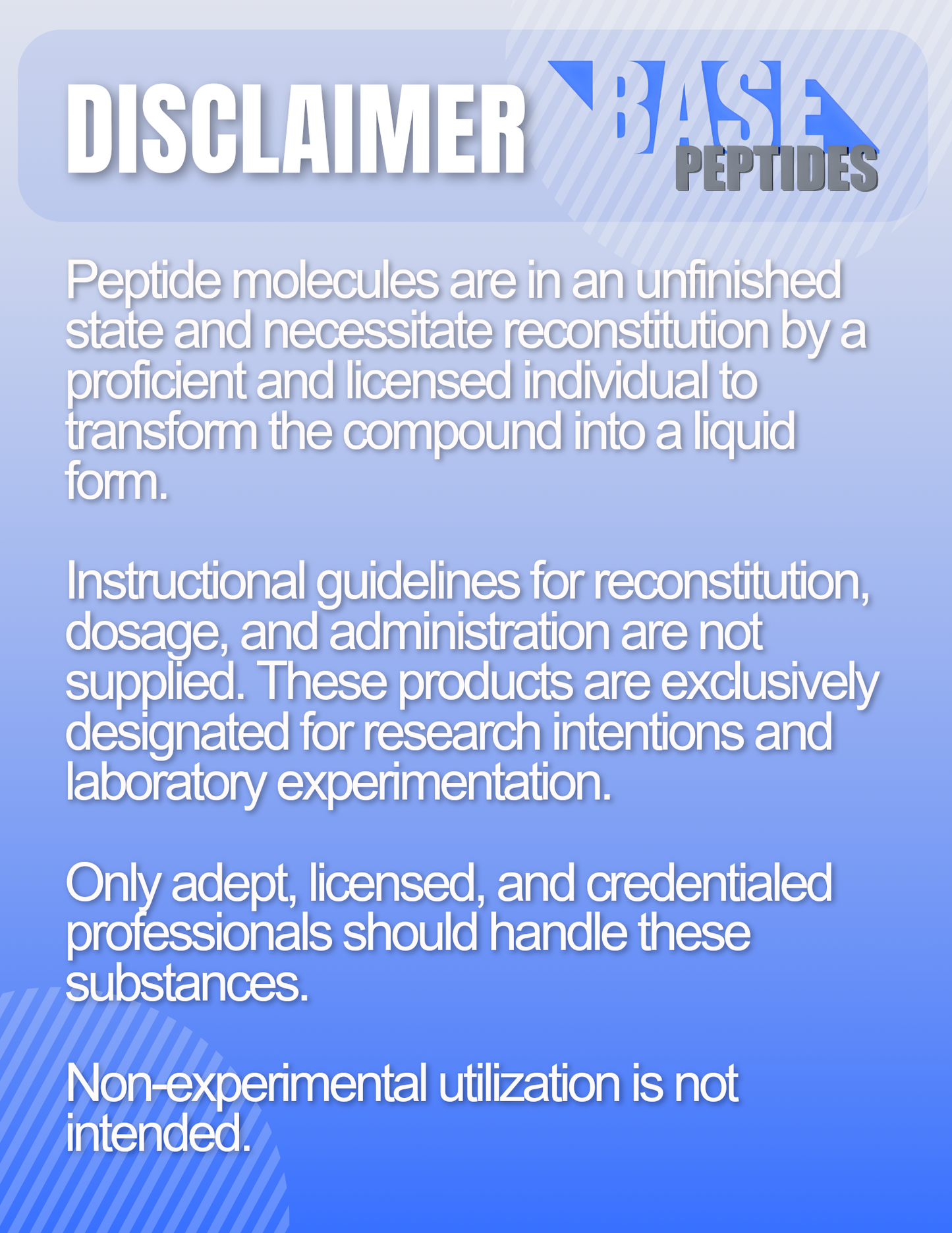IGF-1 LR3
IGF-1 LR3
Base Peptides are intended for licensed medical professionals and experienced researchers. Reconstitution required. Dosing and use instructions are not provided.
Couldn't load pickup availability
IGF-1 LR3 — Long Arg3 Insulin-Like Growth Factor 1 Analog
IGF-1 LR3 is a synthetic variant of natural Insulin‑Like Growth Factor‑1 (IGF-1), engineered to have **prolonged stability**, reduced binding to IGF-binding proteins, and enhanced anabolic signaling. It is used in research to study muscle growth, tissue regeneration, cell proliferation, metabolism, and repair-pathways.
- Synonym: IGF-1 Long R3
- CAS No: 143045-27-6
- Molecular weight (approx): ~9 kDa (≈ 9,000 Da)
- Sequence modifications: Arginine substitution at position 3 (Arg3) & 13-amino-acid N-terminal extension compared to native IGF-1.
- IGF-1 LR3 binds the IGF-1 receptor (IGF1R) triggering signaling cascades (PI3K/Akt, MAPK) which promote **cell growth, survival, and differentiation**.
- Because it binds less strongly to IGF-binding proteins (IGFBPs), it has higher free-fraction availability and longer action compared to IGF-1.
- This makes it a useful research tool for exploring **tissue regeneration, repair, anabolic biology, and metabolic signaling** in cells and in vivo models.
- To study skeletal muscle repair, hypertrophy/hyperplasia, and regeneration after injury.
- To model connective-tissue, bone, cartilage and neuromuscular regeneration in preclinical systems.
- To explore metabolic endpoints: glucose uptake, amino-acid transport, fatty-acid metabolism and cell proliferation in tissue models.
Key Studies — What Was Tested, What Changed, Why It
Muscle growth & regeneration review
- What was tested: Review of IGF-1 and analogues in skeletal muscle & regeneration models.
- What changed: IGF-1 (and analogues) seen to increase muscle-cell proliferation, differentiation and fiber formation in multiple models.
- Why it matters: Supports usage of IGF-1 LR3 in **research on repair and growth** rather than just hypertrophy.
Bioavailability & potency of IGF-1 LR3
- What was tested: Comparative binding-studies and potency analyses of IGF-1 vs IGF-1 LR3.
- What changed: IGF-1 LR3 demonstrated greater potency and longer stability due to reduced IGFBP binding and extended half-life.
- Why it matters: Enables clearer signal in tissue-repair research where IGF-1 action may be masked by binding proteins.
Potential Research Applications
Skeletal Muscle & Injury Repair
- Myoblast proliferation, satellite-cell activation, fiber regeneration.
- Muscle-atrophy models, immobilization recovery, aging muscle.
Connective Tissue / Bone / Cartilage
- Bone-mineralization, cartilage repair, tendon/ligament healing models. [oai_
Metabolic Signalling & Cell-Growth
- Glucose uptake, amino-acid transport, fatty-acid oxidation, stem-cell culture support. [oai_
Synergistic Peptides (for Study Design)
CJC-1295 + Ipamorelin
- Why pair: These peptides stimulate GH/IGF axis upstream, providing complementary mechanistic input.
- Angle: GH-release (CJC + Ipamorelin) → IGF-1 LR3 downstream amplification; compare response and tissue outcomes.
MOTS-c
- Why pair: Mitochondrial energy-metabolism peptide; combining with IGF-1 LR3 allows growth + energy readouts.
GHK-Cu
- Why pair: ECM/trophic environment support; IGF-1 LR3 drives cell proliferation, GHK-Cu supports matrix foundation.
Known Concerns (Context)
- Potent growth factor: Because IGF-1 LR3 is a strong anabolic/proliferative agent, pay close attention to off-target cell growth and tumour-risk models.
- Metabolic cross-talk: IGF-1R overlaps insulin receptor pathways—monitor glucose/insulin signalling if applicable.
- Research-use only: This product is not approved for therapeutic use. Proper labeling and compliance required.
Specifications & Handling
- Form: Lyophilised recombinant peptide/protein (lot-coded) — verify salt/vehicle form.
- Purity: Typically ≥ 98–99 % (HPLC/MS verified) for research-grade.
- Storage: ≤ −20 °C; protect from moisture/light; minimize freeze-thaw cycles.
- In solution: Reconstitute with sterile buffer; document pH; consider carrier protein if low-bind surfaces needed. [oai_
- Packaging: Tamper-evident; research-only labeling; disposal per institutional SOP.
Regulatory & Use Notice
Sold for laboratory research use only. Not for human consumption, medical, or veterinary use. No human-use instructions are provided. Buyer is responsible for safe handling and regulatory compliance.
IGF-1 LR3 Peptide Research | Long Arg3 Insulin-Like Growth Factor-1 Analog | Tissue Repair, Muscle & Metabolism Studies






